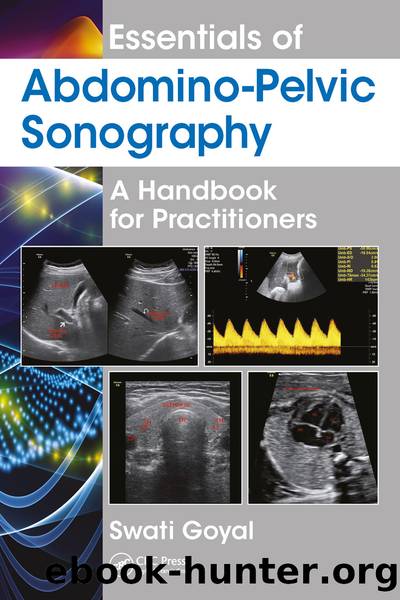Essentials of Abdomino-Pelvic Sonography by Goyal Swati;

Author:Goyal, Swati;
Language: eng
Format: epub
Publisher: Taylor & Francis Group
Causes
1. Maternal diabetes mellitus.
2. Erythroblastosis fetalis.
3. GIT abnormalities such as esophageal and duodenal atresias.
4. CNS abnormalitiesâanencephaly and so on.
5. Cardiovascular abnormalities.
6. Musculoskeletal abnormalities.
Figure 22.3 Illustrating excessive amniotic fluid.
Congenital mesoblastic nephroma and U/L ureteropelvic junction obstruction may be a/w polyhydramnios.
23
Umbilical Cord and Biophysical Profile
INTRODUCTION
Anatomy
First visualized at 8 weeks as a straight thick structure, when diameter <2 centimeters.
Umbilical artery arises from fetal internal iliac artery. In newborn, it becomes the superior vesical artery and the medial umbilical ligament.
Umbilical vein carries oxygenated blood from the placenta to the fetus through ductus venosus into IVC and to the heart.
Single left umbilical vein becomes ligamentum teres and attaches to the left portal vein.
Ductus venosus becomes the ligamentum venosum in newborns.
Allantois is associated with bladder development, becomes urachus and median umbilical ligament.
Yolk stalk connects the primitive gut to yolk sac. The paired vitelline vessels follow the stalk to provide blood supply to the yolk sac.
Cord normally inserts in the central portion of the placenta. May insert marginally and paramarginally.
Velamentous insertionâInsertion of cord beyond the edge into the free membrane.
Vasa previaâFetal vessels running across the internal os of the cervix. Inadvertent rupture of vessels during spontaneous labor may prove fatal. Plan C-section.
Average length of the cordâ59 centimeters (22â130 centimeters)
Short cord may be a/w aneuploidy, extreme IUGR, and so on.
Excessive cord length a/w asphyxia due to excessive coiling, true knots, cord prolapse, and multiple loops of nuchal cord.
Normally contains two arteries and one vein. Vessels of the cord are surrounded by Whartonâs jelly.
Single umbilical artery (SUA), cord cysts, hernias, hematomas, and masses should be excluded.
Download
This site does not store any files on its server. We only index and link to content provided by other sites. Please contact the content providers to delete copyright contents if any and email us, we'll remove relevant links or contents immediately.
| Administration & Medicine Economics | Allied Health Professions |
| Basic Sciences | Dentistry |
| History | Medical Informatics |
| Medicine | Nursing |
| Pharmacology | Psychology |
| Research | Veterinary Medicine |
Machine Learning at Scale with H2O by Gregory Keys | David Whiting(3666)
Fairy Tale by Stephen King(2976)
Will by Will Smith(2595)
Hooked: A Dark, Contemporary Romance (Never After Series) by Emily McIntire(2428)
Rationality by Steven Pinker(2159)
Friends, Lovers, and the Big Terrible Thing by Matthew Perry(2018)
The Becoming by Nora Roberts(1934)
Love on the Brain by Ali Hazelwood(1828)
HBR's 10 Must Reads 2022 by Harvard Business Review(1703)
The Strength In Our Scars by Bianca Sparacino(1702)
A Short History of War by Jeremy Black(1679)
Leviathan Falls (The Expanse Book 9) by James S. A. Corey(1532)
515945210 by Unknown(1525)
Bewilderment by Richard Powers(1456)
443319537 by Unknown(1400)
A Game of Thrones (The Illustrated Edition) by George R. R. Martin(1377)
The Real Anthony Fauci: Bill Gates, Big Pharma, and the Global War on Democracy and Public Health (Childrenâs Health Defense) by Robert F. Kennedy(1340)
The 1619 Project by Unknown(1322)
Fear No Evil by James Patterson(1254)
